Strategic Transformation

The Appleton Greene Corporate Training Program (CTP) for Strategic Transformation is provided by Mr. Remme Certified Learning Provider (CLP). Program Specifications: Monthly cost USD$2,500.00; Monthly Workshops 6 hours; Monthly Support 4 hours; Program Duration 20 months; Program orders subject to ongoing availability.

Personal Profile
TO BE ADVISED
To request further information about Mr. Remme through Appleton Greene, please Click Here.
(CLP) Programs
Appleton Greene corporate training programs are all process-driven. They are used as vehicles to implement tangible business processes within clients’ organizations, together with training, support and facilitation during the use of these processes. Corporate training programs are therefore implemented over a sustainable period of time, that is to say, between 1 year (incorporating 12 monthly workshops), and 4 years (incorporating 48 monthly workshops). Your program information guide will specify how long each program takes to complete. Each monthly workshop takes 6 hours to implement and can be undertaken either on the client’s premises, an Appleton Greene serviced office, or online via the internet. This enables clients to implement each part of their business process, before moving onto the next stage of the program and enables employees to plan their study time around their current work commitments. The result is far greater program benefit, over a more sustainable period of time and a significantly improved return on investment.
Appleton Greene uses standard and bespoke corporate training programs as vessels to transfer business process improvement knowledge into the heart of our clients’ organizations. Each individual program focuses upon the implementation of a specific business process, which enables clients to easily quantify their return on investment. There are hundreds of established Appleton Greene corporate training products now available to clients within customer services, e-business, finance, globalization, human resources, information technology, legal, management, marketing and production. It does not matter whether a client’s employees are located within one office, or an unlimited number of international offices, we can still bring them together to learn and implement specific business processes collectively. Our approach to global localization enables us to provide clients with a truly international service with that all important personal touch. Appleton Greene corporate training programs can be provided virtually or locally and they are all unique in that they individually focus upon a specific business function. All (CLP) programs are implemented over a sustainable period of time, usually between 1-4 years, incorporating 12-48 monthly workshops and professional support is consistently provided during this time by qualified learning providers and where appropriate, by Accredited Consultants.
Executive summary
Strategic Transformation
Because it includes changing a company’s essential essence, strategic transformation is transformation with a capital “T.” From liquid to gas, from lead to gold, from computers to consumer electronics, from advertising to self-driving cars, from retail to cloud computing, from pharmacy retailing to chronic illness treatment, and so on. Strategic transformation, when done well, revitalises a company’s growth engine. When a corporation fails to execute, critics pounce and protest that it should have “stuck to its knitting.”
A business’s main goals and objectives are referred to as strategy. Decisions about strategy have an impact on a company’s line of business, who it serves and how it serves them, as well as how it runs internally. Although it is difficult to forecast exactly what will happen when a company changes its strategy, there are a number of frequent good and bad consequences that occur when a company undergoes a strategic transition.
Significance
All administrative choices, from the front line to the boardroom, are guided by organizational strategy. Strategic plans serve as a road map for companies to realise their owners’ and top-level executives’ great visions in realistic ways. Changing an organization’s strategy can have a significant impact on how it functions, affecting everything from organizational structure to employee daily routines.
Changing your strategy might have a lot of advantages. A company’s ability to react to changes in the legal environment or the marketplace can be aided by new strategic directions. New strategies can assist a company in becoming more productive or cost-effective, or in entering a new, more profitable industry or market niche. Changes in strategy might also assist a company that has been stagnating, recapture its previous growth rates.

The Diamond Methodology
The strategic transformation program’s objective is to enhance or build the strategic planning and execution capabilities at a corporate or business unit level. The program will implement the Diamond Strategic Transformation process covering internal and external analysis, vision development, strategy formulation, strategic planning, and execution.
This program utilizes the “Diamond” methodology, which provides a framework for implementing different training programs for client organizations.
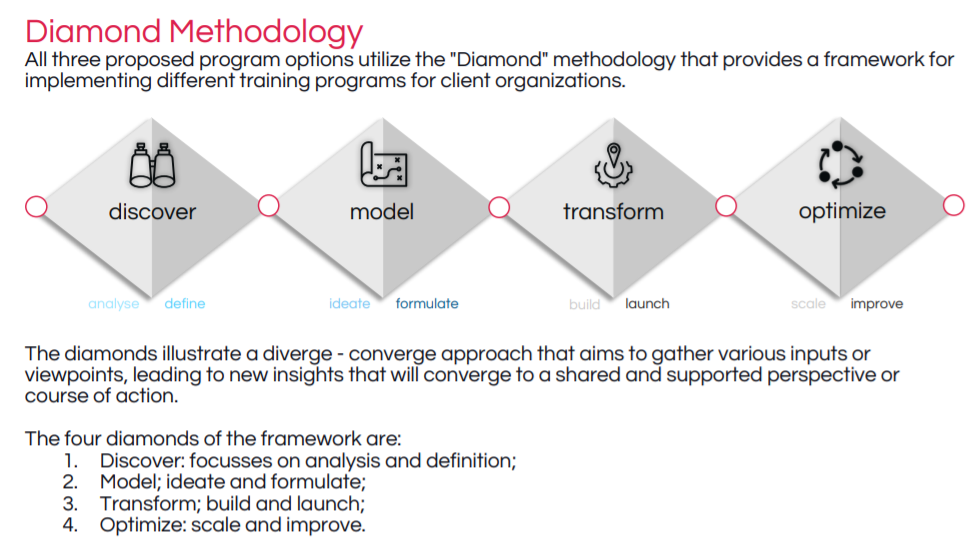
Each phase considers the physical, technological, legal, organizational, environmental, and financial aspects of the subject at hand.
The process is pragmatic but robust, utilizing industry-standard tools and techniques and best practices. The methodology supports traditional development approaches or agile ways of working.
Strategic Transformation is inevitable for businesses that want to thrive and stand the test of time. Companies today have to go through several disruptions and market turbulence quite frequently. In this fast-changing environment, sustainability can only be achieved by adapting and evolving with the consumer, market, and industry demands.
This program aims to help companies, particularly from the Telecommunications, Information Technology, (Managed) Service Providers, Cyber Security and Healthcare industries, to understand what Strategic Transformation is and how it can be achieved through continuous improvement and by challenging the status quo.
Several variables can influence a company’s decision to alter or transform. Market competitiveness is constantly evolving and expanding. When customers have more options, their expectations tend to rise. They’re always on the lookout for a product or service that offers a bit more value than the competition. Technology is also a major motivating force. Newer, technology-driven enterprises that comprehend the current technology landscape and make the most of it have challenged the legacies of many major, established organizations. Products and services evolve in tandem with technological advancements. Customers want the same high-quality services and tailored experiences that tech-driven businesses provide.
Organizations that may have been established years ago with traditional processes and cultures that were once relevant but not any more often find it hard to cope with the changing demands. To remain in the competition, they must evolve with the changing landscape. That is where Strategic Transformation comes in. Strategic Transformation involves setting new goals for the organization and changing the way the business functions, in order to achieve those goals. It requires identifying processes that are not 100 percent efficient and making radical changes to these processes that gradually transform the way the organization operates. This training program on Strategic Transformation will focus on 20 workshops:
Discover
1. Framework Introduction
2. Scope Definition
3. Environmental Analysis
4. Transformation Vision
5. Transformation Principles
Model
6. Business Model
7. Value Proposition
8. Customer Journey
9. Operating Model
10. Transformation Strategy
11. Initiative Ideation
12. Transformation Roadmap
13. Governance & Metrics
14. Transformation Readiness
Execution
15. Transformation Preparedness
16. Innovation Management
17. Portfolio Management
18. Project Management
Optimize
19. Benefit Management
20. Evaluation & Recommendation

Strategy Factors
Strategic planning got inextricably tied to the concept of time somewhere along the road. If tactical plans are short-term, strategic plans must be long-term, the argument went. Annually, strategic plans were supposed to be modified — or even fully rewritten. The most important aspects were to create three- to five-year goals and then move the organization ahead to attain them. These annual rituals gradually degraded into budget predictions and bonus bludgeons that had nothing to do with why customers bought from the company in the first place.
Organizations devote tremendous time, money and management firepower into designing a strategy. There should be clarity in two areas as a result of this strategy: The first is to bring the business’s “table stakes” — conventional customer and staff expectations — up to median. The majority of what most firms accomplish on most days is just meet the basic expectations of consumers or employees. Any customer considering purchasing from your firm does so because of the blocking and tackling.
The attempt to continuously deliver on multiple true competitive advantages is the second factor. These are the characteristics that not only distinguish your company from its competitors, but also that it can cling onto long enough to generate genuine profits. These competitive advantages are what drive clients to choose you over your competitors and buy from you – ideally at a higher price, but even simply getting them to come to you is a victory.
Implementing a strategy entails pushing these two parts as far and as long as possible. You will reap the benefits of a solid strategy the more consistent you are with your employees and customers.
Strategy, however, does not remain static and must adapt. When should you consider changing your plan, is the true question. Four variables typically cause the need to re-evaluate your strategy:
1. Competitors. Customers may fail to notice your advantage if one or more of your competitors has closed the gap on one of your actual competitive advantages. This is, in fact, the whole nature of business. Competitors are always seeking for methods to acquire an advantage, and one way to do so is to take another’s competitive advantage away. A company may have been the industry leader in a specific field, and the leadership just does not comprehend why customers will not continue to reward them for their early leadership after competitors catch up. When a new competitor enters the market in a disruptive manner, another competitor can induce a re-evaluation of strategy.
2. Regulators. One of your competitive advantages could be harmed by a dramatic change in the regulatory environment. Regulatory changes frequently have a broad impact on an entire industry. They have the ability to level the playing field so that clients are no longer enticed by your advantages.
3. Technology. The pricing, development, and/or delivery of your product, service, or offering may be impacted by a substantial technological change. Consumer behaviour may alter as a result of technological advances beyond the traditional sector.
4. Socio-environmental. Significant shifts in society’s direction, such as activism, can have a significant impact on a company’s strategy. Nationalist movements that make previously accepted norms obsolete; eco-activism that affects how things are made or crops are cultivated; and the #MeToo movement, which exposed businesses’ secret practises and forced significant changes in their corporate operations.
A solid strategy method is to regularly analyze these four areas of the environment, looking for changes that could effect the organization’s strategy. This entails creating trigger metrics to show when those changes may have an influence on your company’s strategy. Additionally, it’s crucial to assess the organization’s current competitive advantages and determine if they’re still genuine. If that’s the case, keep everyone’s attention on executing the strategy consistently. However, if these external changes appear to have an impact on the organization’s competitive advantages, it’s time to re-evaluate and possibly re-craft the organization’s strategy.
As a general rule, strategy should be implemented for as long as possible.

Strategic Transformation in the past and where we are today
Whether you’re just starting out as an entrepreneur or have been in business for decades, there’s a good chance you’ve seen a lot of things shift.
The economy has undergone countless changes, each one appearing to be more dramatic than the previous. Offices are no longer recognisable from even a few years ago, thanks to new technology. Because of a new Millennial workforce with different goals than their predecessors, even what motivates employees has changed.
With all of this in mind, it’s no surprise that company strategy has had to evolve as well. Businesses are more aware than ever before that attracting and maintaining the best people is critical to their success.
The Age of Industrial Entrepreneurs (Late 1800s). The entrepreneurial spirit grew in the United States, contributing significantly to the advancement of the American corporate system and raising the standard of living. It resulted in an increase in the demand for produced items.
The Production Era (Through the 1920s). The focus was on creating more things in a shorter amount of time, which led to production innovations such as assembly lines. Internal processes received more attention than external impacts in the business world.
The Marketing Era (Since 1950s). Businesses could no longer expect to sell all of their goods due to the Great Depression. They needed to pay more attention to their goods and service markets. The consumer orientation, which is a business philosophy that focuses on identifying unmet consumer wants and requirements before producing products to meet those needs, was created. They wanted to learn about and meet the needs and preferences of various client groups.
The Relationship Era (began in the 1990s). Transaction management refers to businesses that focus on developing and promoting items in the hopes that enough customers would buy them to cover costs and achieve acceptable profits. They discovered value in long-term relationships with consumers, employees, suppliers, and other businesses.
The Social Era (Since 2000s). This epoch can be defined as a shift in how organizations and individuals interact, connect, communicate, share, and exchange information through virtual communities and networks all over the world. Through the internet and social media, it was a new avenue for businesses and customers to communicate and exchange information. Emphasis on relationship management, which is the collection of activities that help customers and other partners form and sustain long-term, mutually beneficial relationships.
There’s no doubting that we live in a more digital environment, and businesses have had to adapt their tactics quickly to keep up. It’s no longer enough to consider how you present your products and services to potential clients; turning digital has ramifications that include:
• Marketing efforts – most people now view websites on their phone, so having a mobile-friendly site is a must.
• How you communicate with clients and how they communicate with you! Think of all the customer service now taking place on social media, especially Twitter.
• Your internal processes and admin – there are now so many apps that can help you will all aspects of running your business.
In keeping with the concept of ‘change,’ today’s organizations must guarantee that their strategy is adaptable and that they are able to capitalize on new opportunities. This is a hard one because you’ll undoubtedly have a very clear vision of where you want your company to go, and deviating from that can put you in danger of losing your footing.
Adaptability and willingness to shift direction can pay off in the long run – just ask Nintendo, The Gap, and PayPal, all of whom began with completely different strategies from the ones that helped them build a name for themselves.
The new competition is collaboration. Networking has never been easier thanks to technological advancements, and this opens up more options to collaborate directly with firms in your sector and those that complement it.

Future Outlook
The role of leadership in fostering conviction and dedication to a long-term strategic transformation is crucial.
Leaders face numerous hurdles during strategic transformations, which typically last two to three years. For starters, a company may develop a lot of ideas, but there may be no consensus on which ones would move the needle on value creation and which ones should be pursued.
Biases are the second issue. Many management teams have a legacy bias when it comes to how they’ve done things in the past. They may have distributed resources in a particular way in the past and wish to do so again.
The funding of projects is the third aspect of strategic transformation that is extremely difficult. In a performance transformation, the dollars often impact the bottom line rapidly, resulting in a self-funding model. Some of the activities in a strategic transformation may demand a large amount of time or money.
Introducing new products, expanding into new geographies, altering business models, or investing in digital capabilities are all strategic actions that often involve an upfront investment before a company enjoys a financial return. These changes will be made feasible thanks to a finance mechanism embedded into the strategic transformation road map. That’s why strategic transformations are frequently combined with performance transformations, resulting in a self-funding transformation.
Leadership skills for a strategic transformation
Leadership is crucial in fostering long-term strategic transformation conviction and commitment. They must gain agreement from the management team on major decisions, which isn’t always easy. A corporation in the midst of a change is usually at a fork in the road or doesn’t believe it is reaching its full potential. Its executives perceive market upheavals that they need to anticipate. And they’re generally bombarded with suggestions for how to proceed.
Leaders can achieve alignment by comparing all potential moves to the generation of value. This gives management a way to prioritize which changes are most likely to move the needle and decide which ones to carry through.
What does it take to keep a change going? First and foremost, management must stick to the recipe and refrain from declaring triumph too soon. Second, it should reinvest in the pipeline by coming up with new ideas. The companies that are most effective in executing transitions are those that reinvest in their pipeline on a regular basis, as we’ve seen.
Third, in addition to performance, management must pay attention to the health of the organization. This is a crucial aspect that many businesses overlook. Companies that focus on both performance and health outperform those that don’t, according to research.
CEOs must take various actions to succeed in strategic transformations. First, they must show a high level of ambition by setting the bar extremely high and pursuing their company’s maximum potential.
Second, they must have the backing of their board of directors. Because some strategic transformations can decrease profit margins in the first year, a CEO must have the board’s approval before embarking on this journey. Third, you must have the enthusiasm and energy to make multiple large, aggressive movements at the same time.
Another topic concerning strategic transformation that is important to mention is the need of resource reallocation. Resources are notoriously sticky. You must be prepared to reallocate resources because it will be necessary for most strategic reforms to succeed.
Curriculum
Strategic Transformation – Part 1- Year 1
- Part 1 Month 1 Framework Introduction
- Part 1 Month 2 Scope Definition
- Part 1 Month 3 Environmental Analysis
- Part 1 Month 4 Transformation Vision
- Part 1 Month 5 Transformation Principles
- Part 1 Month 6 Business Model
- Part 1 Month 7 Value Proposition
- Part 1 Month 8 Customer Journey
- Part 1 Month 9 Operating Model
- Part 1 Month 10 Transformation Strategy
- Part 1 Month 11 Initiative Ideation
- Part 1 Month 12 Transformation Roadmap
Strategic Transformation – Part 2- Year 2
- Part 2 Month 1 Governance & Metrics
- Part 2 Month 2 Transformation Readiness
- Part 2 Month 3 Transformation Preparedness
- Part 2 Month 4 Innovation Management
- Part 2 Month 5 Portfolio Management
- Part 2 Month 6 Project Management
- Part 2 Month 7 Benefit Management
- Part 2 Month 8 Evaluation & Recommendation
Program Objectives
The following list represents the Key Program Objectives (KPO) for the Appleton Greene Strategic Transformation corporate training program.
Strategic Transformation – Part 1- Year 1
- Part 1 Month 1 Framework Introduction – The objective of organizational change management is to enable organization members and other stakeholders to adapt to a sponsor’s new vision, mission, and systems, as well as to identify sources of resistance to the changes and minimize resistance to them. Organizations are almost always in a state of change, whether the change is continuous or episodic. Change creates tension and strain in a sponsor’s social system that the sponsor must adapt to so that it can evolve. Transformational planning and organizational change is the coordinated management of change activities affecting users, as imposed by new or altered business processes, policies, or procedures and related systems implemented by the sponsor. The objectives are to effectively transfer knowledge and skills that enable users to adopt the sponsor’s new vision, mission, and systems and to identify and minimize sources of resistance to the sponsor’s changes.
- Part 1 Month 2 Scope Definition – What: How to define transformation challenge. Goal: Define clear transformation scope and stakeholders. Why: Establishing a common ground/ understanding of the transformation program scope. Tools: Stakeholder map, Stakeholder tracking sheet, Business recommendation report, Communications plan.
- Part 1 Month 3 Environmental Analysis – What: Identify the key external market, competitor and environmental trends and internal factors that can have positive or negative effects for the organization operating within a given market environment. Goal: Gain insight into an organization’s operating environment, opportunities and threats and competitive positioning. Why: Combining the analysis of both internal and external strengths and weaknesses allows an organization to identify and assess strategic choices. Tools: External Environment STEEPLE- trend analysis (macro trends), Context canvas, Competitor analysis, Porter 5-Forces (industry trends) Internal Environment Survey (questionnaire & interview), Value chain analysis Combined: Strategic SWOT analysis.
- Part 1 Month 4 Transformation Vision – What: Define a compelling vision for the future state of the business and the vision for the transformation that needs to be undertaken. Goal: Define clear transformation scope. Why: Establishing a common ground/ understanding of the transformation program scope. Tools: 5 Bold steps vision canvas Strategy Pyramid/ Strategy map, Vision development, Canvas Cover story vision canvas.
- Part 1 Month 5 Transformation Principles – What: Identify and capture the key dimensions and guiding principles most relevant to the transformation program. Examples include Employee, Customer, Product, Process, Finance, Policy, Markets, Legal & Regulatory, Technology, Governance, Sustainability. Goal: Clearly defined principles to help guide the design of the transformation program and future state operating model. Why: 1) Involvement of all key stakeholders from across the program to drive alignment across the principles. 2) Inform how about guiding principles support transformation execution and what the transformation will deliver (end state). Tools: Transformation Guiding Principles.
- Part 1 Month 6 Business Model – What: Develop the to-be (SOLL) business model in a straightforward, structured way. Goal: Provide insights about the customers the organization serves, what value propositions it will offer through what channels, and how the company makes money. Why: By digging into the elements of the business model, the organization can recognize and act on areas that can be improved. It also reveals clear paths on which to build your transformation and innovation strategy. Tools: Business model canvas review questionnaire: (front stage, backstage, profit formula), Business model canvas.
- Part 1 Month 7 Value Proposition – What: Develop a clear understanding of the customers, including their jobs-to-be-done, pains, and gains, as well as the organization’s offer (value proposition) to them. Goal: Close the gap between what customers want and what the organization offers in order to align the transformation strategy. Why: To help ensure that a product or service is positioned around what the customer values and needs are. Tools: Value proposition canvas.
- Part 1 Month 8 Customer Journey – What: Mapping the customer journey will provide insights into how customers experience a product or service, as well as how they might be better served or even delighted. Goal: Identify where customers get stuck, where they have great experiences, and why. Identify low hanging fruit that the transformation program can deliver on immediately. Why: to get insight into, track, and discuss how a customer experiences a problem the organization trying to solve. Tools: Customer journey canvas.
- Part 1 Month 9 Operating Model – What: Develop a Service Delivery Operating Model on a single-page to suitably represent the current or future state of a business, organization, or function. Develop an organizational impact assessment – to assess the degree of impact across 8 key and proven dimensions. Based on this assessment, the user can then define strategies and tactics to ensure the organizational change is implemented successfully with changes understood, prepared for and risks mitigated effectively. Goal: The target operating model (TOM) is intended to clearly describe the future state aspirational state and structure of the business, process or organization and to understand the impact of the business transformation on each and every affected business unit, function and team. Why: The target operating model (TOM) is intended to allow the organization to focus on the contents and engagement with stakeholders. Tools: Service Delivery Operating Model (TOM), Organizational impact assessment (IST-SOLL).
- Part 1 Month 10 Transformation Strategy – What: Development of a transformation strategy, linked with mission, vision and values and translated down to actions and objectives at the various levels and components of the business. Goal: Establishing a clear thread from “mission” down to “personal actions” following the principles of Hoshin Kanri. The development of the transformation business strategy is conducted in a structured way. Why: To ensure that the strategic goals of the transformation program drive the progress and action at every level, thus eliminating the inefficiencies and misdirection that come from inconsistent strategies, goal misalignment and poor communication. Tools: Strategy pyramid, Stakeholder Disposition Map, Strategy Execution, Management Tooling.
- Part 1 Month 11 Initiative Ideation – What: The purpose of this tool is to fill up an entire wall with the ideas generated by a team in a short amount of time. Goal: Generate a pipeline of transformation, improvement and innovation ideas and identify significant impact initiatives. Why: Harness the collective (untapped) knowledge of the organization and external parties to identify ideas and bring people into the conversation. Tools: Initiative opportunity wall (WIfI), Initiative matrix, Initiative ranking.
- Part 1 Month 12 Transformation Roadmap – What: The transformation roadmap is a visual method for laying out the key initiatives that are required to be delivered as part of a business transformation program. The key initiatives are described in transformation initiative sheets. Goal: Gaining top-down agreement on the major buckets of work that need to be delivered and in what timeframe the business transformation is to deliver on its objectives. Why: To acquire awareness, support and investment in the overarching transformation plan. Tools: Transformation initiative charter, Benefits case, Transformation roadmap.
Strategic Transformation – Part 2- Year 2
- Part 2 Month 1 Governance & Metrics – What: Develop a governance model that encapsulate the operating cadence of the transformation program and shows how management, controls, processes, functions, disciplines come together routinely to drive performance. Goal: Establish a clear and optimized governed operating rhythm aimed at driving objectives and supporting “strategy to execution” effectively and efficiently. Why: To drive operational excellence and assist leaders design a daily/weekly/monthly/quarterly/yearly operating rhythm that is simple but effective. Tools: Business Metrics Definition, Balanced Scorecard Transformation. Governance Tools: – Operating rhythm – Issue management – Status reporting.
- Part 2 Month 2 Transformation Readiness – What: Assess the readiness of a business transformation to be delivered successfully on 6 dimensions: vision clarity & leadership; communications and commitment; transformation capability; project management; culture; stakeholders and progress. Goal: Establish a transformation program baseline that can be compared to subsequent assessments performed during the course of the program execution. Why: To understand how the organization and the program are positioned and when required to make adjustments prior to the commencement of the program and also for making course corrections during the life of the program. Tools: Transformation readiness checklist.
- Part 2 Month 3 Transformation Preparedness – What: A questionnaire that can be utilized with staff, suppliers, partners and other stakeholders to understand their preparedness for major business transformation. Goal: The transformation readiness survey helps to formulate a broad view of the perspectives, attitudes and concerns of a wide variety of individuals who will be impacted by a business transformation initiative. Why: To ensure that impacted stakeholders are understood, engaged and have their concerns promptly addressed. The information gathered can be utilized to make any necessary program adjustments (e.g., communications). Tools: Transformation readiness survey.
- Part 2 Month 4 Innovation Management – What: The process of generating, capturing, evaluating and prioritizing innovation ideas. Goal: Maximize the return on innovation ideas into business growth and success. Why: To discover new transformation options, new products, reduce costs, and enhance your development process significantly. Tools: Innovation campaigns, Initiative canvas, Experiment canvas, Initiative validation canvas.
- Part 2 Month 5 Portfolio Management – What: Develop, execute and manage a balanced portfolio of improvement, renewal, and innovation projects that align to the overall transformation strategy and help resource-allocation and drive actions. Goal: Ensure that the organization selects, initiates, harvests and secures the right initiatives to achieve the transformation goals. Why: To establish and provide clear boundaries that enable comprehension where the organization needs to focused and where not, where to invest, what to eliminate, what to explore and what not. Tools: Project portfolio prioritization, Portfolio map, Resource management plan.
- Part 2 Month 6 Project Management – What: Process ensure on time delivery, within budget, and project scope; it unites clients and teams, creates a vision for a successful project, and gets everyone on the same page of what’s needed to stay on track for success. Goal: Align projects with the transformation strategy. Why: To ensure strategic alignment, leadership and direction, realistic project planning, quality control, risk management, oversight, orderly processes, improves learning capability. Tools: Resource management plan, Project status report, Project update report, Project issue register, Project risk register.
- Part 2 Month 7 Benefit Management – What: process to understand, quantify, and measure the (potential) benefits delivered by the transformation program initiatives. Goal: Provide steering information about how much value/ benefit the transformation initiative delivers versus anticipated. Why: To clarify if the initiative accomplishes its objectives, communicate success, manage expectations, generate ownership. Tools: Benefits case, Transformation Benefits dashboard.
- Part 2 Month 8 Evaluation & Recommendation – What: Structured reflection on programs and projects that can be helpful in promoting continuous improvement. Goal: Generate insights to conclude if the projects were able to meet business goals, what went well, and what can be improved. Why: Create environment of transparency and trust, boost team spirit, help organization to learn, develop and continuously improve. Tools: Transformation conclusion survey, Project evaluation, ABCD-tool Retrospective/ post-mortem
Methodology
Strategic Transformation
The Diamond Methodology
The strategic transformation program’s objective is to enhance or build the strategic planning and execution capabilities at a corporate or business unit level. The program will implement the Diamond Strategic Transformation process covering internal and external analysis, vision development, strategy formulation, strategic planning, and execution.
This program utilizes the “Diamond” methodology, which provides a framework for implementing different training programs for client organizations.

Each phase considers the physical, technological, legal, organizational, environmental, and financial aspects of the subject at hand.
The process is pragmatic but robust, utilizing industry-standard tools and techniques and best practices. The methodology supports traditional development approaches or agile ways of working.
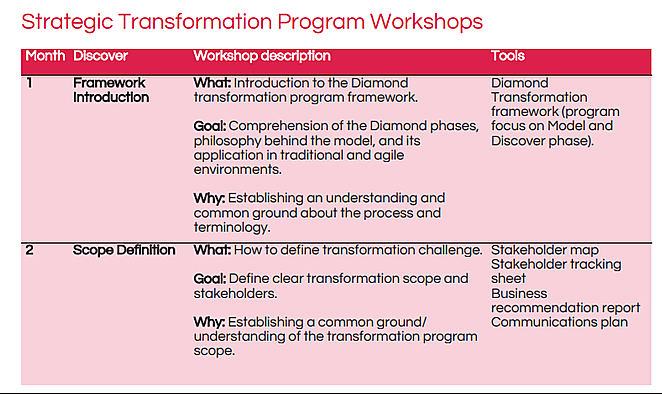
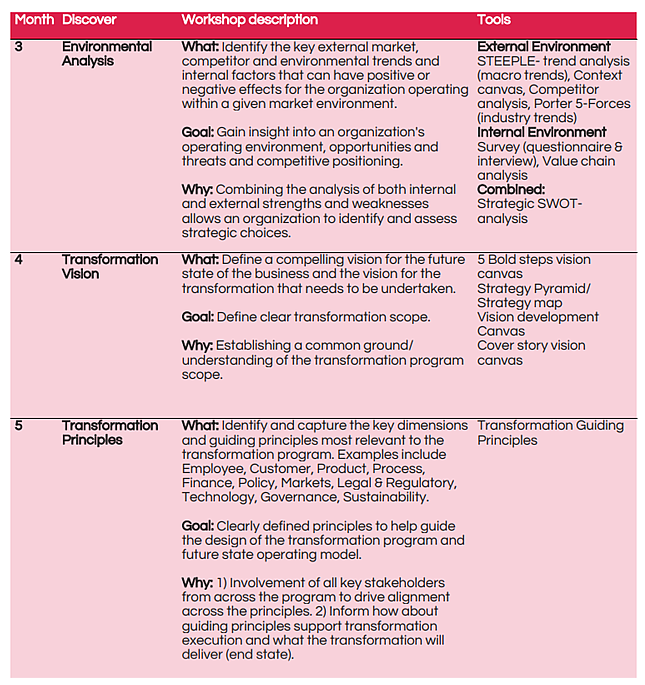
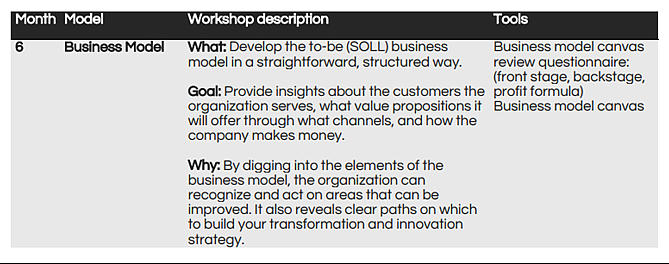
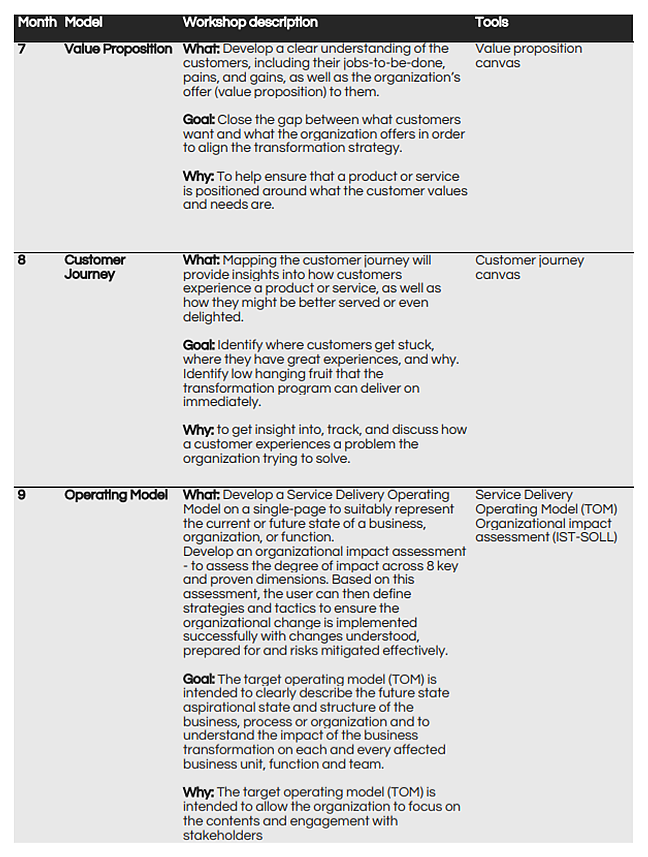
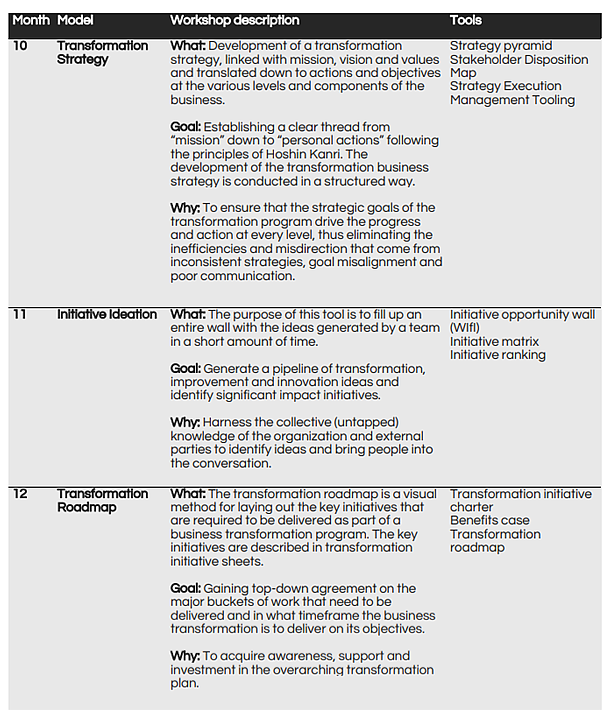
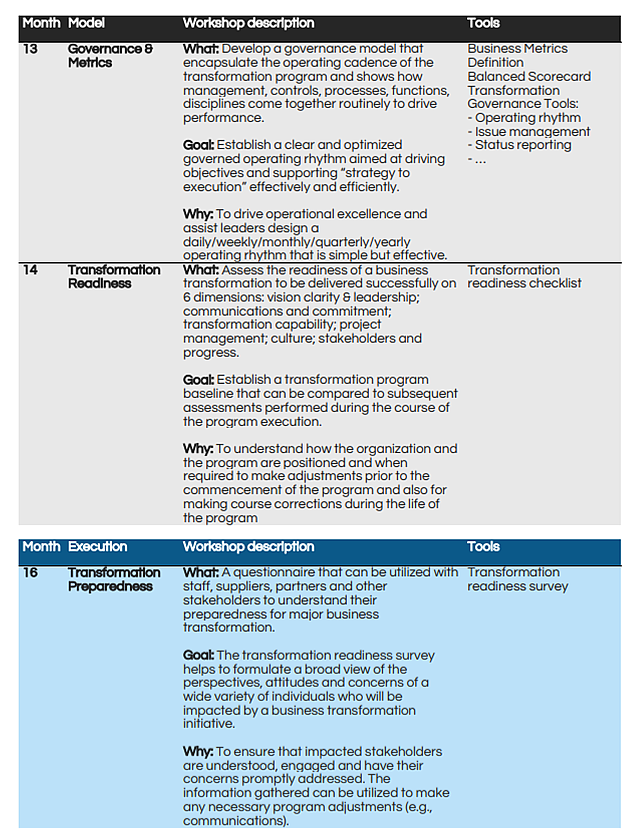
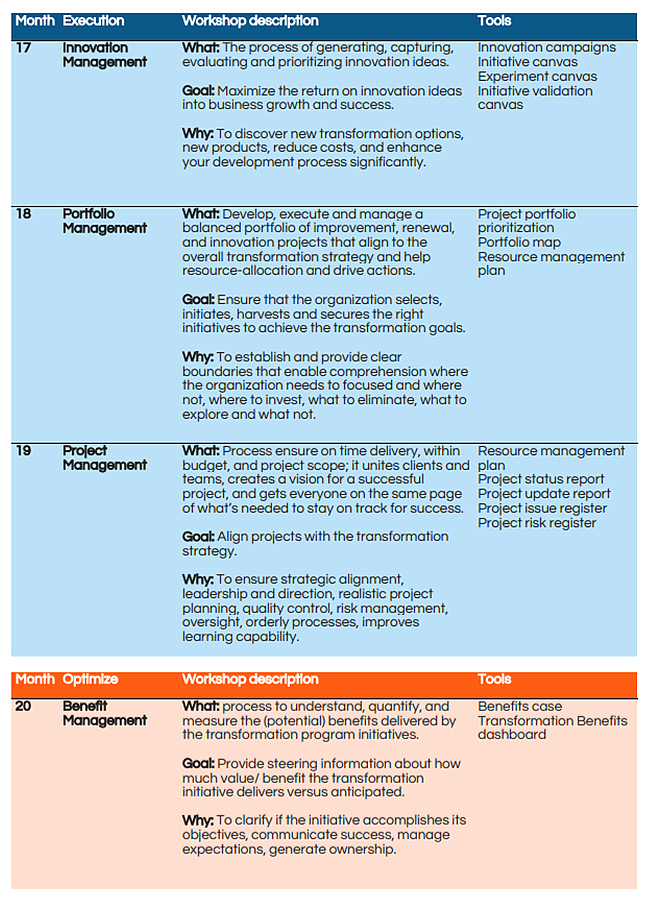
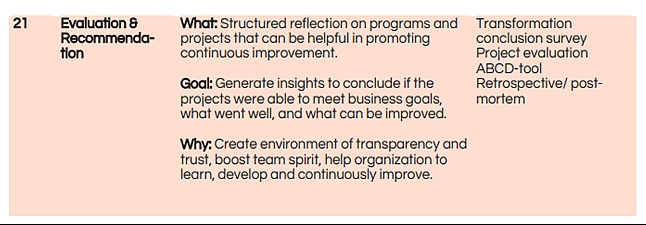
Industries
This service is primarily available to the following industry sectors:

Cybersecurity
Cybersecurity is a critical part of managing risk in today’s climate. Organizations across the globe are feeling the toll of cybercrime, and maintaining business continuity rests on their ability to protect their network and data. To do this successfully, it’s important to understand the different types of cybersecurity and how they defend against cyber threats.
Cybersecurity: Protecting Your Cyber Resources
The U.S. Cybersecurity & Infrastructure Security Agency (CISA) defines cybersecurity as “the art of protecting networks, devices, and data from unauthorized access or criminal use and the practice of ensuring confidentiality, integrity, and availability of information.” The definition from the National Institute of Standards and Technology (NIST) is even simpler: “the ability to protect or defend the use of cyberspace from cyberattacks.”
With these two definitions in mind, let’s take a closer look at some of the types of cybersecurity that you should consider.
Network security
Network security is a broad term that includes the activities and controls designed to protect the integrity of your networking infrastructure — defending the network and the data against threats, unauthorized access, intrusions, breaches, misuse, and so forth.
In broad terms, this type of cybersecurity ensures that your entire underlying network infrastructure, from devices and applications to end-users, is working securely. Since the network is an integral part of their IT ecosystem, this is an area where organizations focus a large part of their security efforts.
Endpoint security
Endpoint security could be considered a subset of network security. But endpoints deserve a separate look in today’s hybrid, mobile workplace, where the network perimeter is no longer defined and employees are using both personal and corporate devices to access the network assets and resources from anywhere.
Trends such as workplace mobility, remote work, and bring your own device (BYOD) create additional risks and complexities for securing endpoints, as well as additional concerns about shadow IT.
Cloud security
Cloud security refers to the technology, policies, and processes you use to mitigate the security risks of cloud computing, whether you’re using public, private, or hybrid clouds. This type of cybersecurity has several unique challenges, such as:
• Visibility: Your in-house IT or security team has less visibility into the data stored in the cloud because the services are accessed outside the network and are managed by a third-party provider.
• The multi-cloud: About three-quarters of organizations have multi-cloud environments, and this trend will likely continue to grow.
• Compliance: The reliance on an outside provider when you use the public cloud adds another layer to your regulatory compliance management process.
Application security
While application security is a major focus for developers, this type of cybersecurity goes beyond the development and design process. Even if you’re only deploying off-the-shelf software and applications, you need to continuously ensure that they remain secure throughout their lifecycle.
Vulnerabilities are one of the biggest risks because cyberattacks use them to gain access into your environment. There are numerous examples of breaches that showed the potential devastation of exploits. For example, the estimated total damage from the WannaCry ransomware campaign—which exploited a weakness in the Microsoft Windows operating system—climbed into the billions of dollars.
Internet security
Internet-borne threats are behind the majority of data breaches. Hacking is the top type of action during the first stage of a breach and the second top action during the middle and end stages—and web applications are the top hacking vectors.
Although other types of cybersecurity, including network and cloud, help defend against internet threats, the prevalence and magnitude of these threats warrant placing internet security into its own category. And while internet security is often viewed as securing the data in transit over the internet, it encompasses much more than that.
Moving toward identity security
As you explore the types of cybersecurity that your organization needs, one area to consider is identity security. Digital transformation and the digitalization of your data mean your operations revolve around access to digital information, and identity security brings tremendous advantages by protecting against threats that target digital identities.
Also known as identity governance or identity management, identity security goes beyond access management to grant, manage, and secure access based on least privilege principles. This ensures that your employees and other users can only access the data and resources they need for typical activities—preventing sensitive data from falling into the wrong hands.

Healthcare
The healthcare sector consists of businesses that provide medical services, manufacture medical equipment or drugs, provide medical insurance, or otherwise facilitate the provision of healthcare to patients.
• The healthcare sector consists of all businesses involved in the provision and coordination of medical and related goods and services.
• This sector enjoys some significant advantages in the U.S. but is also beset with a several factors that present potential economic problems.
• The U.S. healthcare sector accounts for an outsized share of spending relative to health outcomes, which has led to uncertainties around politically driven reform of the industry.
Understanding the Healthcare Sector
The healthcare sector is one of the largest and most complex in the U.S. economy, accounting for 18% of gross domestic product (GDP) in 2020. The U.S. healthcare sector benefits from a strong system of medical research and development, in cooperation with the higher education system and the technology industry. The aging U.S. population and the advancing senescence of the Baby Boomer generation are driving ongoing strong demand in the healthcare sector.
Industries Within the Healthcare Sector
The healthcare sector contains a diverse array of industries, with activities ranging from research to manufacturing to facilities management.
Drugs
Drug manufacturers can further be broken down into biotechnology firms, major pharmaceutical firms, and makers of generic drugs. The biotech industry consists of companies that engage in research and development to create new drugs, devices, and treatment methods.
Many of these companies are small and lack dependable sources of revenue. Their market value may depend entirely on the expectation that a drug or treatment will gain regulatory approval, and FDA decisions or rulings in patent cases can lead to sharp, double-digit swings in share prices. Examples of (larger) biotech firms include Novo Nordisk (NVO), Regeneron ( REGN), Alexion ( ALXN), Vertex ( VRTX), Gilead Sciences Inc. (GILD), and Celgene Corp. (CELG).
Major pharmaceutical firms also engage in research and development but tend to focus more on manufacturing and marketing an existing portfolio of drugs than the typical biotech firm. These companies tend to have more dependable streams of revenue and a more diversified “pipeline” of drugs in the research and development stages, making them less dependent on make-or-break drug trials and their shares less volatile. Examples of major pharmaceutical firms include Johnson and Johnson, Roche, Pfizer, Eli Lilly, Novartis AG. GlaxoSmithKline, and Astrazeneca.
Some pharmaceutical firms specialize in generic drugs, which are identical to name-brand drugs but no longer enjoy patent protection. As a result, there is often competition to manufacture identical drugs, leading to lower prices and thinner profit margins. An example of a generic drugs firm is Teva Pharmaceutical Industries Ltd.
Medical Equipment
Medical equipment makers range from firms that manufacture standard, familiar products—scalpels, forceps, bandages, and gloves—to those that conduct cutting-edge research and produce expensive, hi-tech equipment, such as MRI machines and surgical robots. Medtronic PLC is an example of a medical equipment maker.
Managed Healthcare
Managed healthcare companies provide health insurance policies. The “Big Five” firms that dominate the managed Medicaid industry are UnitedHealth Group Inc., Anthem Inc., Aetna Inc., Molina., and Centene.2
Healthcare Facilities
Healthcare facilities firms operate hospitals, clinics, labs, psychiatric facilities, and nursing homes. Examples include Laboratory Corp. of America Holdings, which operates facilities that perform blood tests and other analyses, and HCA Healthcare Inc., which operates hospitals and other healthcare facilities in the U.S. and U.K.

Telecommunications
Telecommunication is the transmission of information by various types of technologies over wire, radio, optical, or other electromagnetic systems. It has its origin in the desire of humans for communication over a distance greater than that feasible with the human voice, but with a similar scale of expediency; thus, slow systems (such as postal mail) are excluded from the field.
The transmission media in telecommunication have evolved through numerous stages of technology, from beacons and other visual signals (such as smoke signals, semaphore telegraphs, signal flags, and optical heliographs), to electrical cable and electromagnetic radiation, including light. Such transmission paths are often divided into communication channels, which afford the advantages of multiplexing multiple concurrent communication sessions. Telecommunication is often used in its plural form.
Other examples of pre-modern long-distance communication included audio messages, such as coded drumbeats, lung-blown horns, and loud whistles. 20th- and 21st-century technologies for long-distance communication usually involve electrical and electromagnetic technologies, such as telegraph, telephone, television and teleprinter, networks, radio, microwave transmission, optical fiber, and communications satellites.
Data is transmitted in a telecommunications circuit by means of an electrical signal called the carrier or the carrier wave. In order for a carrier to convey information, some form of modulation is required. The mode of modulation can be categorized broadly as analog or digital.
In analog modulation, some aspect of the carrier is varied in a continuous fashion. The oldest form of analog modulation is amplitude modulation (AM), which is still used in radio broadcasting at some frequencies. Digital modulation actually predates AM; the earliest form was Morse code. Modern telecommunications use internet protocols to carry data across underlying physical transmissions.
Telecommunications industry and service providers
Telecommunications systems are generally run by telecommunications service providers, also known as communications service providers. These providers historically offered telephone and related services and now offer a variety of internet and WAN services, as well as metropolitan area network (MAN) and global services.
In many countries, telecom service providers were primarily government-owned and operated. That is no longer the case, and many have been privatized. The International Telecommunication Union (ITU) is the United Nations (UN) agency that administers telecommunications and broadcasting regulations, although most countries also have their own government agencies to set and enforce telecommunications guidelines. In the United States, the Federal Communications Commission (FCC) is the primary regulatory agency.
A large umbrella of companies provide different types of telecommunications services, including internet service providers (ISPs), telecom equipment providers, wireless service providers, radio and television broadcasters, cable companies, satellite television providers and managed service providers (MSPs).
The three main segments within the telecom industry are manufacturers of telecom equipment, telecom services and wireless communications. Within these sectors, telecom equipment – which includes customer equipment, such as routers and modems; transmission equipment, such as transmission lines and wireless semiconductors; and analog or digital public switching equipment – is the largest, and wireless communications is the smallest.
Recently, service providers have been focusing on growing services, such as data and video, as opposed to voice communication services.

Information Technology
Information technology is the study, design, development, implementation, support or management of computer-based information systems—particularly software applications and computer hardware. IT workers help ensure that computers work well for people.
Information technology (IT) covers any form of technology, that is, any equipment or technique used by a company, institution, or any other organization which handles information. It incorporates computing, telecommunication technologies, and includes consumer electronics and broadcasting as it is getting more and more digitized. Spearheaded by the computer, the decades since the mid-1960s have been characterized by an extreme development. Since the late 1970s, cheap microelectronics have permitted the diffusion of these technologies into almost all aspects of daily life and have furthermore almost inextricably cross-fertilized and intermingled their multiple application branches, which include industry, commerce, administration, education, medicine, scientific and professional work, entertainment, and domestic work.
The fundamental capabilities that usually are perceived as being essential are: chip design, production facilities, and a common network infrastructure like the Internet for the storage and transmission of digital multimedia information (including video, audio, and other continuous media data in addition to conventional data and text).
Nearly every company, from a software design firm, to the biggest manufacturer, to the smallest “mom & pop” store, needs information technology workers to keep their businesses running smoothly, according to industry experts.
The phrase “information technology” goes back to a 1958 article published in the Harvard Business Review. Authors Harold J. Leavitt and Thomas L. Whisler defined several types of information technology:
• Techniques for the fast processing of information
• The use of statistical and mathematical models for decision-making
• The “simulation of higher-order thinking through computer programs.”
“While many aspects of this technology are uncertain, it seems clear that it will move into the managerial scene rapidly, with definite and far-reaching impact on managerial organization,” they wrote.
Six decades later, it’s clear that Leavitt and Whisler were onto something big. Today, information technology refers to everything that businesses use computers for. Information technology is building communications networks for a company, safeguarding data and information, creating and administering databases, helping employees troubleshoot problems with their computers or mobile devices, or doing a range of other work to ensure the efficiency and security of business information systems.
What are the IT industry trends?
In its IT Leaders 2020 report, BCS, The Chartered Institute for IT, assessed the capabilities, skills and ethics required by IT organisations in the near-term future. It showed that business transformation and organisational change were among the top priorities for these firms.
Driven by the advancements in digital technologies, the use of data, and the need to remain secure, the report revealed how respondents now prioritised cyber security, cloud, IT governance, automation and the as-a-service model (for example, SaaS, PaaS, IaaS) just ahead of Agile methods, mobile/apps, big data, AI, the internet of things, machine learning and 5G.
The manipulation of data is a skill that cannot be overlooked, especially with the rise in awareness of the relatively new data scientist role. We’ll also be hearing more about roles in blockchain, a system of delivering information in a fully automated and safe manner.

Managed Service Providers
Managed service provider defined
A managed service provider (MSP) is an outsourcer contracted to remotely manage or deliver IT services such as network, application, infrastructure, or security management to a client company by assuming full responsibility for those services, determining proactively what technologies and services are needed to fulfill the client’s needs.
Services delivered by an MSP are delivered by employees located at the client’s locations, or elsewhere. MSPs can also bundle in hardware, software, or cloud technology as part of their offerings.
Managed service provider business model
Adopting managed services is intended to be an efficient way to stay up-to-date on technology, have access to skills and address issues related to cost, quality of service and risk. As the IT infrastructure components of many SMB and large corporations are migrating to the cloud, with MSPs (managed services providers) increasingly facing the challenge of cloud computing, a number of MSPs are providing in-house cloud services or acting as brokers with cloud services providers. A recent survey claims that a lack of knowledge and expertise in cloud computing rather than offerors’ reluctance, appears to be the main obstacle to this transition. For example, in transportation, many companies face a significant increase of fuel and carrier costs, driver shortages, customer service requests and global supply chain complexities. Managing day-to-day transportation processes and reducing related costs come as significant burdens that require the expertise of Transportation Managed Services (or managed transportation services) providers.
Managed service providers structure their business to offer technology services cheaper than what it would cost an enterprise to do itself, at a higher level of quality, and with more flexibility and scalability. This is achieved through efficiencies of scale, as an MSP is able to hire specialists that smaller enterprises in particular may not be able to justify, and through automation, artificial intelligence, and machine learning — technologies that client companies may not have the expertise to implement themselves.
What differentiates managed service providers from traditional outsourcing companies is that when an enterprise outsources an IT department or function, the outsourcing company either picks up those employees or replaces them with a roughly equivalent number of employees elsewhere. An MSP, however, focuses not on the jobs themselves, but the end results the customer seeks. For example, an enterprise might contract an MSP to handle support calls to a certain level of satisfaction and response time. As long as the managed service provider meets those metrics, it doesn’t matter whether it uses dedicated staff, automation, or some other system to handle calls for that customer; the MSP decides.
There is a great deal of overlap between these definitions, however, and many companies traditionally thought of as offering business process outsourcing are now operating more as managed service providers.
Managed services also differs from traditional IT consulting arrangements in that consulting is typically project-based, while managed services are ongoing subscriptions.
Locations
This service is primarily available within the following locations:

London, UK
History
London, being a port city noted for its vast stature and western opening, was always a favourite with visitors from all across Europe and the world. During the ninth century, the Vikings attacked London several times, leading to the settlement of Danish inhabitants in the city’s suburbs. These newcomers from Denmark brought with them dreams and business ideas, which they put into action in London. London was quickly turned into England’s first urban centre as a result of these business methods. The rise of trade, as well as the opening of new businesses and central avenues, aided in the advancement of London’s image and perspective.
London’s ever-expanding port became a European hub for the distribution of commodities from off-shore businesses during the fourteenth century. During the fifteenth century, these activities were bolstered, thanks in part to a boom in the local textile industry.
The Great Fire of London in 1666 caused irreversible damage to the city’s walls and structure. However, thanks to the high quality of construction and the masterpieces of architect Christopher Wren, the city’s heart was completed in just over ten years. With so much going on in a regular month or day, London finally became the capital of theatrical events, museums, and societies of the English social life.
In 1694, London took its first financial step forward with the establishment of the Bank of England. The Bank of England’s foundation set the groundwork for the world’s second central bank. Millions of people flocked to the city during the Industrial Revolution, resulting in a significant increase in employment and economic activity. In 1963, London was divided into many segregated boroughs to make management easier and assure correct funding allocation, resulting in a dramatic reduction in the region’s overall population.
Current Position
The service industries, such as financial services and other sectors, today dominate commercial operations in London. London is not only the United Kingdom’s capital, but also one of the world’s most important financial centres. It also serves as a command centre for the global economy, and it is critical to the advancement of the global economy.
With about 841,000 private sector enterprises based in London alone at the start of 2013, London is known to contribute over 22% of the UK’s GDP. London has more businesses per capita than any other region or county in the United Kingdom.
After WWII, London’s economy transitioned to one based mostly on services. The following factors contributed to London’s growth as a service industry:
• English is the region’s native tongue, as well as the primary international language for most companies.
• The capital of the vast British Empire was London. All of the Empire’s territories acknowledged London as a service and financial center.
• London’s central time zone allows it to serve as a link between the United States and Asian markets. It is also strategically placed in Europe’s services-heavy economy, allowing for larger and more effective expansion initiatives.
• The United Kingdom’s robust foreign policy has aided London’s emergence as an economic center greatly. The United Kingdom has significant ties with a number of countries in Asia, the Middle East, and Africa, particularly those belonging to the Commonwealth of Nations.
• Because English contract law is widely employed by firms all over the world, London is regarded as a legal centre.
• Heathrow Airport serves as a vital link between key countries.
London’s financial exports are regarded as among the best in the world, making it a considerable contributor to the UK’s balance of payments. When it comes to cities with the best financial competitive hub, London is second only to New York City. The rising real estate market also aids the building industry in making London a regional economic hub.
Future Outlook
As the city of London recovers from the COVID-19 pandemic, doubts regarding the city’s future are being raised. Some believe that rather than being concentrated in a few centralized hubs, the economy’s future lay in distributed economic activity. The argument about whether we’ve hit peak London has intensified in recent years, and there are now questions about whether the city still has anything to offer.
Even before the first traces of the COVID-19 epidemic appeared, London’s economy and city life had come to a halt. London’s international reputation has been deteriorating for some time, since there are growing concerns about the city’s future business environment.
London is currently in a vulnerable situation, but municipal officials have a great opportunity to alter the city’s perspective and deliver a fresh narrative to inhabitants and communities all over the world.
The City of London Corporation has developed its own plans for London in 2025, focusing on establishing the suitable environment and retaining existing firms and people while attracting new ones. The city’s future depends on the kind of living it can provide. In its current fragile situation, London has lost ground to other more developed cities, but there is still hope if management can enhance the quality of life and work toward a better lifestyle for citizens.

Antwerp, Belgium
History
Antwerp’s economic life has long been inextricably linked to its status as a seaport, which is inextricably linked to the city’s advantageous geographic location as well as the port’s infrastructure and functions. The city established a significant sugar-refining industry in the 16th century, in which partially worked sugarcane was sent in, refined, and reexported. During the 1920s and 1930s, the first petroleum refineries were built, and they were quickly followed by vehicle assembly plants. After WWII, industry grew at a breakneck pace. In the 1960s, larger petroleum refineries and chemical plants were built, followed by petrochemical industries, and the automotive sector was reformed on a greater scale.
Photographic and electronic equipment, as well as cut diamonds (for which Antwerp is famous), are other key products. The first diamond, according to legend, was cut in Antwerp in 1476. Cutting and dealing establishments have prospered in the so-called diamond area adjacent to the Central Station since the 16th century, and Antwerp has become the international diamond capital. It also grew into a significant fashion hub.
Many commercial agencies, commission agents, import and export corporations, financial establishments, insurance companies, road-transport enterprises, and railways support Antwerp’s complex of harbour and industrial activity.
Current Position
Belgium’s GDP increased to EUR 479,122 million in 2015, compared to EUR 356,125 million in 2010. The province of Antwerp contributed 16 percent of the total in 2015 (EUR 75,365 million).
The petrochemical, logistics, and knowledge sectors are the most important in Antwerp’s economy. Tourism adds less value to the economy, although it is nevertheless comparable to the fashion and diamond industries (all around EUR 300 million). However, visitors are considered as making a significant contribution to other industries in the new city marketing plan, thus a straight comparison of value added is not a practical means of measuring the importance of tourism to Antwerp’s economy. Belgium’s economy is closely integrated in Europe’s. In recent years, its growth has generally been very slightly faster than the Eurozone’s. 4.2.2 GDP per capita At purchasing power parities (PPPs) the available figures suggest that Belgium’s GDP per capita is 12% higher than the European average. And within Belgium, Antwerp stands out with a GDP per capita that is 47% higher than the EU average.
The City of Antwerp has 6,846 companies that have to file accounts every year as well as 3,805 self-employed who all provide business services. The companies generate a total added value of 4.4 billion euros, with a workforce of 60,490 employees. Business services by far are the city’s biggest activity, in terms of the number of companies and especially in terms of the workforce employed. In terms of added value the business services sector is comparable with industry.
Largest sectors by number of companies:
• Consultancy (1.637)
• Financial services (1.134)
• ICT services (842)
Largest sectors in terms of added value:
• Temp agencies and placement (1.4 billion euros)
• Head offices (790 million euros)
• Architects and engineers (359 million euros)
Future Outlook
The Financial Times’ acclaimed information centre on international investment is FDi Intelligence. The business world anticipates their annual rankings of enterprising cities with bated breath. This year, a group of specialists analysed 129 locations based on their international entrepreneurship potential and attractiveness.
Antwerp, as the sole Belgian city, enters the ranking of cities with the greatest economic potential in the category of cities with populations of up to 2 million people for the first time. According to the panel, Antwerp is deserving of this high position because of its international investment strategy, particularly in the areas of digital innovation, sustainable chemistry, and retail. Antwerp’s digital marketing strategy is highly praised by the jury.
The Port of Antwerp is pushing back the boundaries with innovations that will make the port greener in order to become carbon neutral by 2050. For example, for its own fleet, the Port of Antwerp has incorporated sustainably produced methanol and hydrogen as alternative fuels. They are working with other industries to reduce pollution in the air, water, and soil. They’re also searching for ways to help with the energy transition via projects like Antwerp@C and NextGen District, among others.

Amsterdam and the rest of the Netherlands
History
The city of Amsterdam has a rich and interesting history. The city’s beginnings may be traced back to the 12th century, when fisherman living along the Amstel’s banks erected a bridge across the stream at the IJ, which was then a vast saltwater inlet. The community was protected from rising IJ waters by wooden locks beneath the bridge, which frequently inundated the early settlement. The Damrak established a natural harbour at the mouth of the Amstel River, which became significant for trading-exchange between larger koggeships and smaller ships that sailed the products deeper into the countryside.
The 17th century was the Dutch civilization’s golden period. Intellectual independence was enjoyed by Benedict de Spinoza and René Descartes, and Rembrandt and Johannes Vermeer created their masterpieces. As a result of the Dutch East India Company’s acquisition of Asian colonies, the country’s quality of life rose dramatically. The territory was taken by the French during the French revolutionary wars and became the Kingdom of Holland under Napoleon in the 18th century, when Dutch marine dominance collapsed (1806). In World War I, the Netherlands remained neutral, and in World War II, it declared neutrality, but was overrun by Germany. It lost the Netherlands Indies (Indonesia from 1949) and Netherlands New Guinea after the war (in 1962; now the Indonesian provinces of Papua and West Papua). It became a founding member of the European Economic Community and NATO in 1949. (later renamed the European Community and now embedded in the European Union). The Netherlands had a robust, well-regulated mixed economy at the start of the twenty-first century, but it battled with the social and economic issues of immigration.
Current Position
According to the World Bank and the International Monetary Fund, the Netherlands’ economy will be the 17th largest in the world in 2021 (in terms of GDP). In the fiscal year 2019/20, its GDP per capita was predicted to be at $57,101, making it one of the world’s wealthiest countries (see list of countries by GDP (PPP) per capita). Annual economic growth (GDP) averaged over 4% between 1996 and 2000, significantly above the European average of 2.5 percent at the time. As a result of the early 2000s recession, growth slowed significantly in 2001–05. However, during 2006 and 2007, the economy grew at a rate of 3-4 percent per year. The Dutch economy was hit considerably by the financial crisis of 2007–2008, and the ensuing European sovereign-debt crisis.
The Netherlands has had steady natural gas resources since 1959, when a wellspring was discovered. Currently the Netherlands accounts for more than 25% of all natural gas reserves in the European Union. Over the following decades, the sale of natural gas generated a significant rise in revenue for the Netherlands. However, the unforeseen consequences of the country’s energy wealth originally impacted the competitiveness of other sectors of the economy, leading to the theory of Dutch disease, after the discovery of the vast Groningen gas field.
The Netherlands has a prosperous and open economy, which depends heavily on foreign trade. The economy is noted for stable industrial relations, fairly low unemployment and inflation, a sizable current account surplus (which, compared to the size of the country, is even more than Germany) and an important role as a European transportation hub. Rotterdam is by far the biggest port in Europe, and Amsterdam has one of the biggest airports in the world. Industrial activity is predominantly in food processing, chemicals, petroleum refining, high-tech, financial services, the creative sector and electrical machinery. Its highly mechanised agricultural sector employs no more than 2% of the labour force, but provides large surpluses for the food-processing industry and for exports. The Netherlands, along with 11 of its EU partners, began circulating the euro currency on 1 January 2002.
Future Outlook
Amsterdam is experiencing a population boom due to its draw as a progressive and central urban hub in the European knowledge economy. According to the Amsterdam City Council, as many as 150,000 inhabitants are expected to migrate into the city between now and 2040.
In order for Amsterdam to expand intelligently, the Amsterdam City Council developed the comprehensive new Structural Vision Amsterdam 2040 city master plan, integrating innovative urban design and neighborhood rejuvenation strategies, myriad smart technology systems, and more advanced mobility options for residents and visitors. The overarching goal is to densify existing communities and build new suburban business, commercial and residential districts that maximize space as efficiently as possible within the A10 ring road encircling the city.
In the space between the urban core and the ring road, Amsterdam is populating huge swaths of post-industrial riverfront real estate and the outlying Amsterdam Noord and Zuidas districts to create a new “Metropolitan Amsterdam Area” and the smart city master plan of the future.

Barcelona, Spain
History
Barcelona’s early human settlements date back to the Neolithic period. The city was created by the Romans, who established a colony known as Barcino around the end of the first century BC. The colony had a population of a few thousand people and was surrounded by a defensive wall, the ruins of which can still be seen in the old town.
Barcelona was under Muslim domination for about 200 years before becoming a Carolingian county and one of the primary residences of the Crown of Aragon’s court following the Christian reconquest. Barcelona’s status as the Western Mediterranean’s commercial and political centre was cemented during the prosperous mediaeval period. The Gothic Quarter of the city provides testament to the city’s splendour from the 13th to the 15th century.
Barcelona experienced a period of decline from the 15th to the 18th century, as it strove to maintain its economic and political independence. This conflict came to a close in 1714, when the city surrendered to Bourbon troops, and Catalonia’s and Catalans’ rights and privileges were curtailed. With the rise of the textile industry in the mid-nineteenth century, a period of cultural revival began. Catalan regained importance as a literary language during this period, known as the Renaixença.
The twentieth century saw widespread urban renovation in Barcelona, culminating in the city’s iconic Eixample area, which houses some of the city’s most distinctive Catalan art-nouveau, or modernista, structures. One of the most notable architects in Catalonia, Antoni Gaud, constructed buildings such as the Casa Milà (known as La Pedrera in Catalan), the Casa Batlló, and the Sagrada Famlia cathedral, which have become world-famous landmarks.
During the Civil War in 1936 and the dictatorship that followed, the liberties gained during this time were drastically curtailed. Barcelona society recovered its economic strength and the Catalan language was reinstated with the restoration of democracy in 1978. Barcelona’s hosting of the 1992 Olympic Games reinforced the city’s standing as a major metropolis and gave it a new lease on life.
The Forum of Cultures reclaimed industrial zones in 2004 in order to turn them into residential districts. An illustration of Barcelona’s newfound zeal in approaching the twenty-first century.
Current Position
It is one of the most densely inhabited urban centres in Western Europe, with a population of 1.6 million people. It has a cosmopolitan population, with 20.2 percent of residents hailing from other countries, primarily Italy, China, and Pakistan. There are almost 200 languages spoken in the city, but Catalan and Spanish are the official languages. Catalonia’s most major self-governing institutions, such as the Generalitat de Catalunya and the Catalan Parliament, are also located in the city.
In recent decades, Barcelona has moved away from its manufacturing roots, embracing new industries including as media, biotechnology, energy, and design. It also employs over half of all creative-industry workers in Spain. In 2018, the sector employed 135,000 Barcelona residents, or 12.2% of the city’s employment. The city continues to be the economic engine of the Catalan region, accounting for more than half of the employment and GDP.
Barcelona City Council is the city’s primary cultural agent, however other regional and national agencies provide financing. As seen by significant programs like the Barcelona Cultural District, which delivers free cultural activities to neighbourhoods around the city, the city views culture as both a fundamental right and a critical component of social development. This project prioritises both the foreign and the local, bringing programming to people’s homes while also encouraging international artists to visit, whether for a long-term residence or a few performances. It also supports cross-disciplinary programmes, as seen by the fact that culture, science, and education have all been under the Deputy Mayor for Culture since mid-2019.
The city is a hub for tourism, which is welcomed for its income, but which requires planning to ensure that the city remains a sustainable home for its local population. Programmes such as the Art Factories are in place to ensure that artists are still able to live, work and thrive in the city.
Barcelona is also a UNESCO City of Literature, reflecting its long association with publishing for the international market, and its 41 libraries, which are the central cultural hubs of the city, attracting 6.4 million visitors each year. It also has 59 theatres and 57 museums spread across the city. The city’s Design Hub (known as DHUB) built in 2012, is a flagship site for the creative industries. Multi-functional and multi-disciplinary, it aims to turn the city’s emerging design sector into a leader in Europe. It is part of District 22@, a project which turned nearly 500 acres of derelict industrial land in the Poblenou neighbourhood into a new, high-tech innovation district. This is typical of an approach that aims to preserve and re-use buildings from the industrial period for new uses.
Culturally, the City’s programming is aimed at uniting people and reducing inequality – giving all its citizens a voice in its democracy and access to all the culture that Barcelona has to offer.
Future Outlook
Residents of Barcelona discovered that several of their streets were not as they remembered them when Spain relaxed its stringent pandemic lockdown in the middle of 2021. Two of the three car lanes on the Consell de Cent, a major thoroughfare that passes through the city centre, had been lost to an expanded walkway that was now painted yellow.
The adjustments, which were initially labelled by municipal officials as “provisional,” are still in place a year later, despite resistance from some business organisations. More is on the way as part of a proposal to turn 21 roadways totaling 33 kilometres (20 miles) into pedestrian green spaces. The initiative demonstrates how the epidemic has influenced global urban design, hastening measures such as more bike lanes and fewer cars in the face of mounting climate change concerns.
Barcelona has recovered about eight hectares of cityscape from motor cars since March 2020, converting it into sidewalks, parks, bike lanes, and restaurant terraces, stating that people needed greater space to avoid COVID-19. Barcelona has actively exploited the pandemic to embrace an urban renovation, similar to Paris, which has been adding additional bike lanes. Xavi Matilla, Barcelona’s top architect, said the city had adapted well to fewer car lanes, and that increased pedestrian space could help local trade.
According to Matilla, the health crisis has demonstrated that unless cities become greener, more people would leave, following those who have already relocated to rural places with better air quality and more outdoor space in the last year. “The epidemic has served as a magnifying glass, allowing us to see how health should be one of the most important components of city administration and development,” he said, adding that Barcelona was considering urban transformation efforts with London and Paris.
By 2030, Barcelona’s leftist municipal government hopes to convert a third of the streets in the Eixample neighbourhood, which is known for its Modernist architecture, into a so-called pedestrian green axis, with the first four, including Consell de Cent, completed by 2023.
Program Benefits
Management
- Process improvement
- Business sustainability
- Decentralized approach
- Seamless transformation
- Stakeholder management
- Time efficient
- Proactive evaluation
- Achieving excellence
- Collaborative transformation
- Performance improvement
Production
- Productivity improvement
- Process improvement
- Waste reduction
- Sustainable transformation
- Transforming productivity
- Cost reduction
- Profit centers
- Empowering employees
- Engage stakeholders
- Product improvement
Customer Service
- CSI
- Process improvement
- Performance improvement
- Customer retention
- Consumer engagement
- Interactive process
- Personnel commitment
- Talent retention
- Seamless transition
- Improved globalization
Testimonials

Testimonial 1
Content here…

Testimonial 2
Content here…

Testimonial 3
Content here…

Testimonial 4
Content here…

Testimonial 5
Content here…
More detailed achievements, references and testimonials are confidentially available to clients upon request.
Client Telephone Conference (CTC)
If you have any questions or if you would like to arrange a Client Telephone Conference (CTC) to discuss this particular Unique Consulting Service Proposition (UCSP) in more detail, please CLICK HERE.











